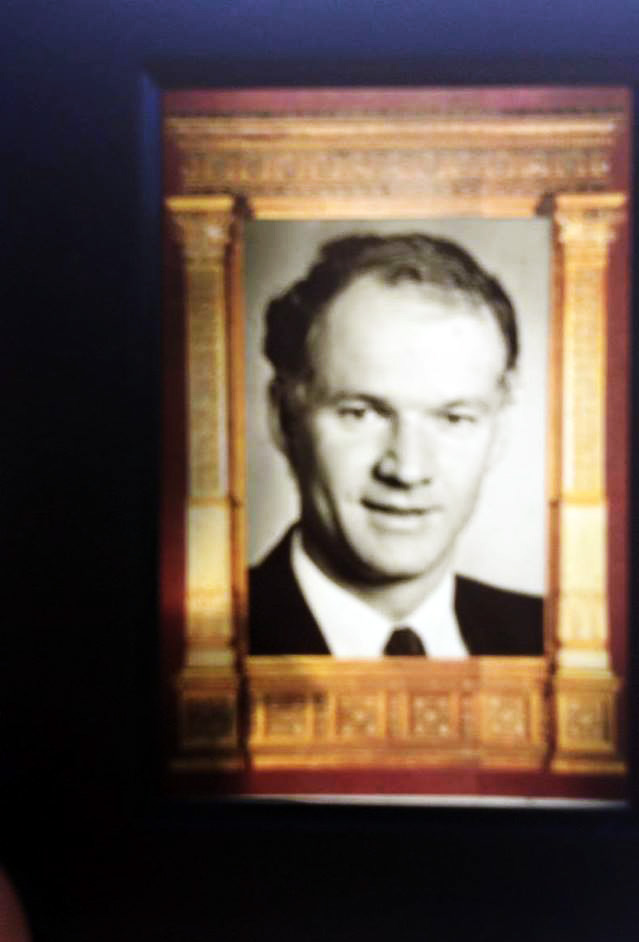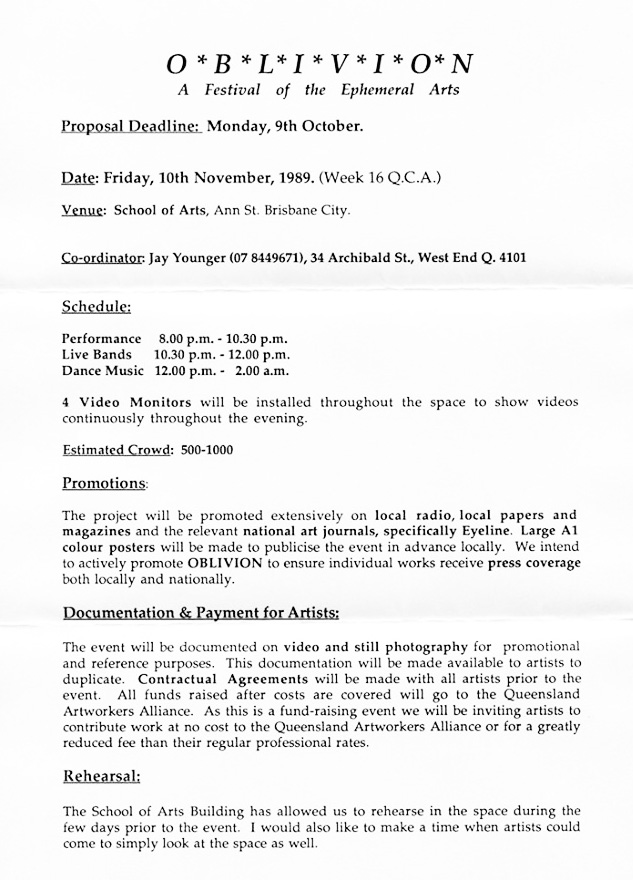A brief history of bubbles …
By Adam Boyd
There are some compelling reasons why Ephemeral Traces, the UQAM exhibition curated by Peter Anderson, and ARI Remix are of cultural and historical importance. Both of them examine the 1980’s and 90’s art scene in Brisbane as viewed through the lens of artist-run spaces, both are concerned with writing forgotten or neglected histories, but most importantly they both aim to set the historical record straight by giving the artists themselves control over those histories. It is the artists voices that tell the stories, not historians.
So what was that history? What were the main cultural and conceptual drivers at the time?
The political sphere in Brisbane in the1980’s was a kind of a bubble. The governing National Party saw themselves as a bulwark against an encroaching world view they didn’t agree with for their own weird ideological reasons. The Hawke/Keating Labor government was in power for much of the time, and successive Labor governments in each of the states and territories. Nationally the political pendulum was swinging to the left while the Nationals held on inside their bubble, stuffing cash into paper bags.
Sadly, theirs was an ideology still familiar to us today and clearly visible in contemporary conservative politics. The Nationals held tightly to an unfashionable collection of ideas that were so out of step with the direction the western world was moving that to the naked eye it looked like the pendulum had stopped swinging sometime around 1956.
The National Party view of civil society was one where women were kept in the home cooking and ironing, safe from the threat of communist agitators. The White Australia Policy could still be openly discussed on its merits. Greenies and Aborigines were radical elements best ignored but if push came to shove, they should be crushed. The police force was an extension of the legislature. The white shoe brigade was in charge of coastal development. Selective protectionism floated among the wreckage of free market economics. Notions like decency, fairness and equality struggled under the strange moral authority of Bjelke-Petersen’s Lutheran Christian ideology. This is not an allegorical account, nor embellishment. It is fact. It makes the transformation of Queensland’s political and cultural spheres in recent times all the more extraordinary.
In any case that was the bubble of conservative politics in Queensland for twenty-seven years. I’ll just say that again; twenty-seven years! With the benefit of today’s retrospect-a-scope, the National Party bubble looks a lot like the ones that existed in eastern block countries at the same time. Pretty much like the bubble North Korea is still locked into today. As the Nationals eventually found out, the thing about bubbles is that although they’re a lot of fun when you’re in them, in the end you run out of oxygen.
Small wonder that against this backdrop a generation of younger and emerging artists simply went out and made bubbles of their own. This is an interesting point in the cultural history of Queensland because in the 1980’s the local avant-garde is as much a story about architecture and civic spaces as it is about art.
The city was in the middle of a demolition and construction boom barely imaginable today. They just couldn’t demolish the old buildings fast enough. Entire precincts became negative spaces, histories disappeared overnight. The Dean Brothers (demolition experts to the stars) made good on their promises. All they left behind were the memories. What the planners could not have foreseen was that in that urban chaos a generation of artists and artist run spaces flourished, moving into old retail and warehouse spaces that nobody with any business sense wanted.
It wasn’t hard to occupy those spaces and roam the city claiming it for yourselves, any more than it was hard to move into the conceptual and critical void that existed in the local arts culture. It wasn’t exactly contested territory; it was more like moving into a vacuum. Art was happening everywhere, covertly, and was headquartered in old buildings in Charlotte Street, George Street, Roma and Little Roma Streets.
Performance and installation flourished in a way they never had previously in Brisbane. New modes of engagement were invented. The fact that engagement was not valued or validated by the establishment was a moot point. The space of your own making is always more valuable than the ones you are excluded from.
Eventually, at the top end of George Street, not the hole-in-the-ground end (Roma Street), the National Party Government collapsed following some unsavoury corruption scandals and the Fitzgerald Inquiry into Police Corruption in 1989.
Time had finally caught up with the Nationals. Their brown paper bags stuffed with bribes had burst, along with their bubble. The subsequent election of Wayne Goss and the Labor Government in 1989 was a euphoric moment. There were celebrations in the street and many moments of profound personal joy, one of those ‘Where were you on 9/11?’ moments.
Artist and colleague Virginia Barratt and I expressed something of that spirit in an uncharacteristically political performance during the Oblivion: Festival of the Ephemeral Arts held at the Brisbane School of Arts on Friday 10 November, 1989 and curated by artist and educator Jay Younger. I say political, but that’s not strictly true. It was also personal. In fact, all we really wanted from it at the time was that it just be simple and affirming. More general than specific but no more than that.
‘The Three Minute Kiss’ involved a slide projection of Wayne Goss beneath a Triumphal Arch in the English Classical Romantic tradition. We went on stage and kissed beneath that projection to the sound track of the band Sweet Honey and the Rock singing ‘Where are the keys to the kingdom?’ (Open the doors and let me in!). We stood up there in front of everyone we knew and kissed one long, steady kiss for the duration of the song, then turned and left the stage.
The performance called to mind the iconic photograph of the American sailor in the V Day celebrations at the end of World War 2, kissing a girl in Times Square. It was a declaration of hope and faith in a new order at one and the same time. It was a celebration of the promise we could not see, but could feel. Things were going to change.
As it turned out it was also a kind of a good bye kiss. I had set off for Melbourne and set up another artist run space, ‘The Greater Western’ in West Melbourne . Virginia was based in Adelaide to head up the Australian Network for Art and Technology (ANAT). The Nationals were off to purgatory. They were not missed.
In ‘The Three Minute Kiss’ Virginia and I were celebrating more than just a change of Government. We were celebrating Brisbane’s entry into the twentieth century, and nothing illustrated the promise of that more than the achievements of the artist run spaces at the time.
That little performance, ‘The Three Minute Kiss’, was as simple as it was elegant, and only now can I see another narrative, one that has been hidden to me at least, for nearly thirty years. It was a cautionary tale. Three minutes is all you get. Enter the Campbell Newman Government of 2012.
See history remade. See the bubble blown again, and then burst all over. Just don’t laugh too loud. History loves a head on a pike.
And there’s the rub. I see now what I could never have anticipated thirty years ago. History can never be agreed upon. It can never be fixed to an agreed position. It is always, must always be, tied to the present. It can tell you the basic facts but we need razor sharp 20:20 hindsight to fill in the rest. That’s why we need histories like the ones being built through Ephemeral Traces and ARI Remix. So we can do the housework that history demands. Clean things up. Take stock. Flesh out the memories we have and build on them. Give them the benefit of perspective and experience and try our best not to slip into nostalgia.
What it all means for young artists today is a matter for them.
Here is a link to the famous photo first published in Life Magazine:
WIKIQUOTE:
“V-J Day in Times Square, a photograph by Alfred Eisenstaedt, was published in Life in 1945 with the caption, In New York’s Times Square a white-clad girl clutches her purse and skirt as an uninhibited sailor plants his lips squarely on hers…”
Artist Profile
The Ephemera Interviews
Related Archival Resources
No related posts.



